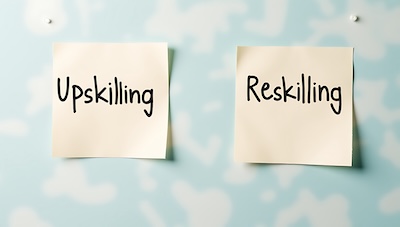
Decoding the Next Steps in AI

Blog Author: Chuck Royal, Associate Partner, Data and Technology Transformation
As AI continues to change how government operates, this series will explore the applications of AI in the public sector, innovative case studies, use cases, and the potential impact on governance, service delivery, and citizen engagement.
We begin the series with a report from Davos. Every year, in Davos, Switzerland, the World Economic Forum (WEF) holds its annual meeting. Leaders from across the globe both in public and private sectors discuss a range of topics that are most pressing. Below are highlights of the meeting, as they relate to the U.S. Federal Sector.
Insights on AI from Davos 2025: Decoding the Next Steps in AI
The 2025 WEF in Davos, themed "Collaboration for the Intelligent Age," brought together global leaders to discuss transformative technologies like AI. Among the many sessions, two stood out: "AI Lifting All Boats" and "Reskilling for the Intelligent Age." These sessions highlighted critical challenges and opportunities in advancing AI adoption and application. Here are three key takeaways that emerged:
- Building Educational Infrastructure for AI Adoption
To bridge the gap between AI innovation and practical application, organizations must prioritize educational systems that empower employees to utilize AI effectively. This involves:
- Reskilling workforces to understand and integrate AI into daily tasks.
- Creating accessible learning platforms to demystify AI tools and processes.
- Encouraging cross-functional collaboration to break down silos and foster a culture of innovation.
By investing in education, organizations can unlock AI's potential as a tool for productivity and innovation rather than a source of fear or resistance.
Importance to agencies: Investing in the architecture of AI is costly and takes time for implementation. Reskilling and upskilling a workforce can start immediately. Through education, employees can adopt the new technology faster and build trust through experience of working with AI applications.
- Leveraging AI Assistants as Work Multipliers
AI assistants are no longer just futuristic tools—they are becoming essential work multipliers. These systems can:
- Automate repetitive tasks, freeing up human workers for strategic activities.
- Enhance decision-making through predictive analytics and real-time data insights.
- Improve operational efficiency across industries, from healthcare to finance.
However, successful implementation requires addressing barriers such as outdated infrastructure, algorithmic opacity, and organizational resistance.
Importance to agencies: The federal workforce is tasked with increasing productivity with data daily. This increase in work and data may lead to delays and impact the quality of work. In leveraging an AI assistant, employees can help analyze, increase efficiency, and make data-driven decisions quickly.
- Redefining Productivity in the AI Era
AI has the power to compress timelines for innovation and productivity:
- Tasks that traditionally took years can now be completed in months with AI-driven solutions.
- Organizations must shift their focus from incremental improvements to exponential growth enabled by AI technologies.
- This requires embracing a mindset of agility and adaptability to keep pace with rapid technological advancements.
Importance to agencies: The advancement of Generative AI opened new doors for productivity. In the past, a defined logic of steps was needed for automation. Now we can rethink what AI is able to do. This thinking of AI means assessing the work and understanding the tasks associated. Understanding the next level of what the exact task we are completing allows for AI integrated solutions (i.e. real time policy generation, review of organizational procedures for redundancy and conflicts, form review and translation to determine recipients, etc.).
Conclusion: From Innovation to Application
Davos 2025 underscored the need for a pragmatic approach to AI adoption. While innovation continues at a breakneck pace, the focus must shift toward applying these advancements in meaningful ways. By investing in education, leveraging AI as a multiplier, and redefining productivity metrics, government can navigate the challenges of the Intelligent Age and harness AI's transformative potential.
As global leaders emphasized during these sessions, collaboration—across industries, nations, and sectors—will be key to ensuring that AI lifts all boats rather than leaving some behind.



